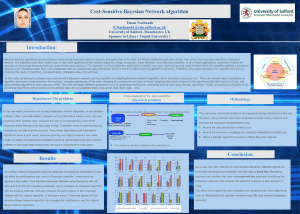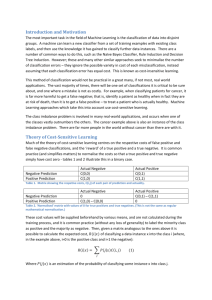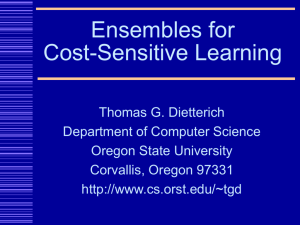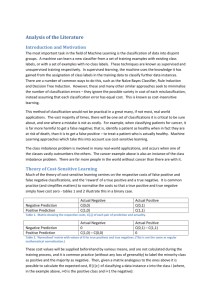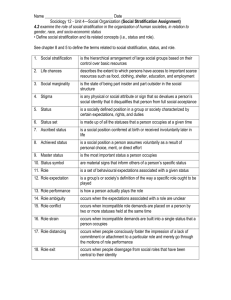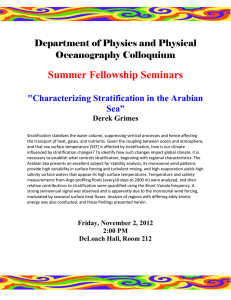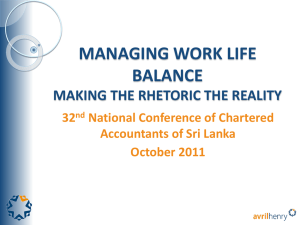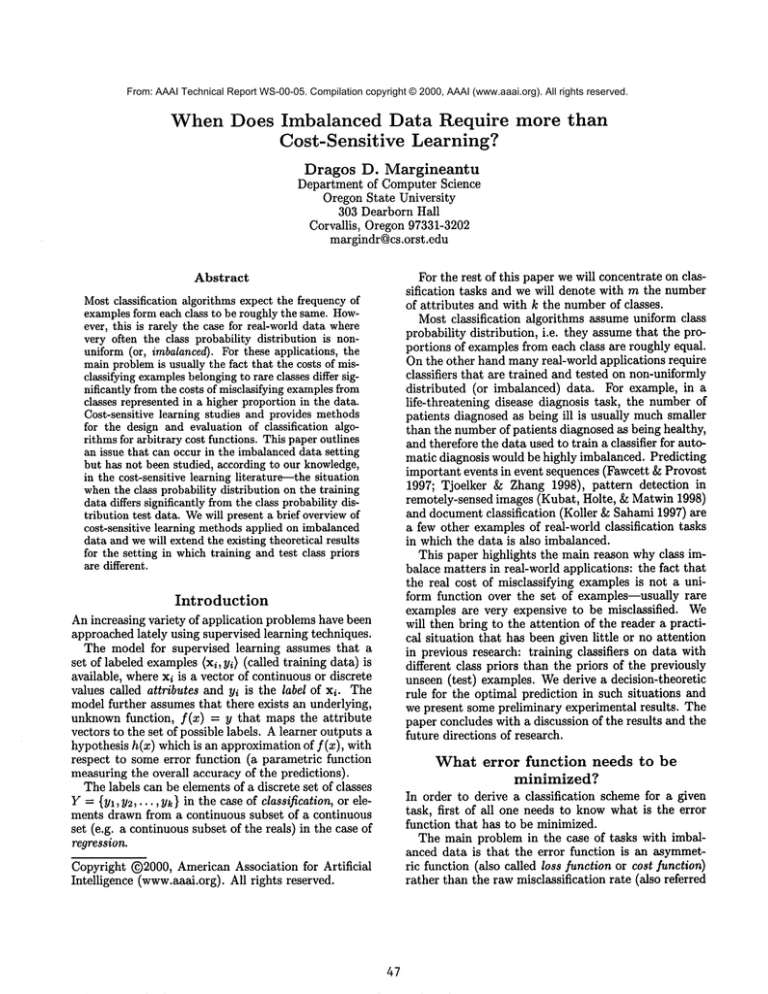
From: AAAI Technical Report WS-00-05. Compilation copyright © 2000, AAAI (www.aaai.org). All rights reserved.
When Does Imbalanced Data Require more than
Cost-Sensitive
Learning?
Dragos D. Margineantu
Department of Computer Science
Oregon State University
303 Dearborn Hall
Corvallis, Oregon 97331-3202
margindr@cs.orst.edu
Abstract
Most classification algorithms expect the frequency of
examplesform each class to be roughly the same. However, this is rarely the case for real-world data where
very often the class probability distribution is nonuniform (or, imbalanced). For these applications, the
mainproblemis usually the fact that the costs of misclassifying examplesbelongingto rare classes differ significantly from the costs of misclasifying examplesfrom
classes represented in a higher proportion in the data.
Cost-sensitive learning studies and provides methods
for the design and evaluation of classification algorithms for arbitrary cost functions. This paper outlines
an issue that can occur in the imbalanceddata setting
but has not been studied, according to our knowledge,
in the cost-sensitive learning literature---the situation
whenthe class probability distribution on the training
data differs significantly fromthe class probability distribution test data. Wewill present a brief overviewof
cost-sensitive learning methodsapplied on imbalanced
data and we will extend the existing theoretical results
for the setting in whichtraining and test class priors
are different.
Introduction
An increasing variety of application problems have been
approached lately using supervised learning techniques.
The model for supervised learning assumes that a
set of labeled examples(x~, Yi) (called training data)
available, where xi is a vector of continuous or discrete
values called attributes and Yi is the label of x~. The
model further assumes that there exists an underlying,
unknown function, f(x) = th at ma ps th e at tribute
vectors to the set of possible labels. A learner outputs a
hypothesis h(x) which is an approximation of f(x), with
respect to some error function (a parametric function
measuring the overall accuracy of the predictions).
The labels can be elements of a discrete set of classes
Y = {yl,y2,... ,yk} in the case of classification, or elements drawn from a continuous subset of a continuous
set (e.g. a continuous subset of the reals) in the case
regression.
Copyright @2000,American Association for Artificial
Intelligence (www.aaai.org). All rights reserved.
For the rest of this paper we will concentrate on classification tasks and we will denote with m the number
of attributes and with k the number of classes.
Most classification
algorithms assume uniform class
probability distribution, i.e. they assume that the proportions of examples from each class are roughly equal.
On the other hand manyreal-world applications require
classifiers that are trained and tested on non-uniformly
distributed (or imbalanced) data. For example, in
life-threatening disease diagnosis task, the number of
patients diagnosed as being ill is usually muchsmaller
than the numberof patients diagnosed as being healthy,
and therefore the data used to train a classifier for automatic diagnosis would be highly imbalanced. Predicting
important events in event sequences (Fawcett & Provost
1997; Tjoelker & Zhang 1998), pattern detection in
remotely-sensed images (Kubat, Holte, & Matwin 1998)
and document classification (Koller & Sahami 1997) are
a few other examples of real-world classification tasks
in which the data is also imbalanced.
This paper highlights the main reason why class imbalace matters in real-world applications: the fact that
the real cost of misclassifying examples is not a uniform function over the set of examples--usually rare
examples are very expensive to be misclassified.
We
will then bring to the attention of the reader a practical situation that has been given little or no attention
in previous research: training classifiers on data with
different class priors than the priors of the previously
unseen (test) examples. Wederive a decision-theoretic
rule for the optimal prediction in such situations and
we present some preliminary experimental results. The
paper concludes with a discussion of the results and the
future directions of research.
What error
function
needs
to be
minimized?
In order to derive a classification scheme for a given
task, first of all one needs to knowwhat is the error
function that has to be minimized.
The main problem in the case of tasks with imbalanced data is that the error function is an asymmetric function (also called loss ]unction or cost ]unction)
rather than the raw misclassification rate (also referred
Different
class priors
on the training
and on the test
data
Wewill further study what is the optimal output of
a classifier whenthe class priors (i.e., the frequency of
classes) on the training data are different from the class
priors for the test examples. The class priors on the test
data are assumed to be known.
Let the probability values that refer to the training
data be denoted as Pt and the probability values that
refer to the test data be denoted as Ps. The priors of y
on the training and on the test data will be denoted as
Pt(Y) and Ps(Y), respectively.
Wewill assume that within each class the underlying
probability density is the same for both the training
and the test data: Pt(x]y) = P~(x]y), and we will also
assume that Pt (x) = Ps (x).
Fromthe definition of the conditional probability we
get:
to as 0/1 loss). It is usually the case that the misclassification of examplesthat belong to rare classes induces
a high misclassification cost.
Cost-sensitive learning (Turney 1997) studies methods for building (Pazzani et al.
1994; Knoll,
Nakhaeizadeh, & Tausend 1994; Bradford et hi. 1998;
Kukar & Kononenko 1998; Domingos 1999) and
evaluating (Bradley 1997; Provost & Fawcett 1997;
Margineantu &: Dietterich 2000) classifiers whenthe error function is different from the 0/1 loss.
In general, in cost-sensitive learning, the error function may be described either by a k × k cost matrix C,
with C(i, j) specifying the cost incurred when an example is predicted to be in class i whenin fact it belongs
to class j, or by a k-dimensional cost vector L, with
L(i) specifying the cost of misclassifying an example
that belongs to class i. It is easy to observe that a cost
vector L is equivalent with a cost matrix C in which
the diagonal values are equal to 0 and C(i, j) = L(j)
for all extra-diagonal values.
The procedure that has been most oftenly applied
in learning from imbalanced data is stratification, i.e.
changing the frequency of classes in the training data
in proportion to the costs specified in the cost vector.
Stratification
can be achieved either by oversampling
or by undersampling the available data. The two main
shortcomingsof stratification is that it is not straightforward how it can be applied when the error function
is represented as a cost matrix (see (Margineantu &Dietterich 1999) for possible solutions and a discussion on
this issue) and, second, it distorts the original distribution of the data.
Another possible approach to the data imbalance
problem (and to cost-sensitive problems in general)
based on the class probability estimates of the examples, P(y]x). Assuming that we have a procedure that
computes good estimates for the class probabilities of
the examples, the optimal output of the classification
procedure is the class label for which the value of the
conditional risk (Duda & Hart 1973) is minimized:
Pt (ylx)
and, similarly:
Ps(y[x)-
yEY
Ps(x]y)Ps(Y)
(4)
P.(x)
From (3) and (4) and from the assumptions made
obtain:
,x. P.(Y)
P.(ylx) p.
= JP-7
(5)
Whenwe plug this result into (1) we get the expression for the optimal prediction on an unseen (test) example:
(6)
h(x) = argmin ~
yE Y~1"=
which becomes:
k
h(x) = argmin ~-~ P(yjIx)C(y, yj)
,
(3)
h(x)
(1)
ar gmin
k Ps(YJ)Pt"
Z ~ (Y jl )
x’L"
(Y (7)
yEO j-~l,yjy£y
j:l
for an error function represented by a loss vector L.
or, equivalently, for a loss vector L:
k
h(x)
= argmin
~ P(yj]x)L(yj).
(2)
yEY j----1,yj~y
This also assumes that the class frequencies in the
training data are the same as the class frequencies that
will be encountered on the test data--a condition that
sometimes doesn’t hold either because of the nature of
the process that generates the data or because of the
preprocessing of the training data by the means of a
stratification procedure.
48
Experiments
Wehave conducted some preliminary tests using three
classification methods.
Our first method is C4.5-avg, a version of the C4.5
algorithm (Quinlan 1993) modified to accept weighted
training examples(this is equivalent to stratification).
Each example was weighted in proportion to the average value of the column of the cost matrix C corresponding to the label of the example. This is the average cost (over the training set) of misclassifying examples of this class. (Breimanet al. 1984) suggests a similar methodfor building cost-sensitive decision trees and
o.0
10/\
Table 2: The cost models used in our experiments.
Unif[a, b] indicates a uniform distribution over the [a, b]
interval. P(i) represents the prior probability of class i
(from the second column in Table 1.
o__ /
/
/ o,-,,/ \/...............
//\ ’
Cost
Model
M1
M2
M3
~au l
lo
-10
-5
0
5
c(i, j)
i ¢j
Unif[0, 1000x P(i)/P(j)]
Unif[0, 10000]
Unit~0, 2000x P(i)/P(j)]
c(i,i)
0
Unif[0, 1000]
Unif[0, 1000]
could not reject the null hypothesis whenthe classifiers
built by MetaCost-C4 and BagCost-C4 were compared.
On the other hand, both MetaCost-C4 and BagCost-C4
outperformed the decision tree classifier on all tasks.
10
Figure 1: Decision boundaries for the Expf5 data set.
Conclusions and Discussion
Table 1: Description of the two tasks on which we ran
the tests.
I Class Frequencies I
Class Frequencies I
on Test Data
.._J
This paper has emphasized the cost-sensitive
nature
of the data imbalance problem in classification tasks.
Wehave briefly reviewed some cost-sensitive procedures
that are frequently applied in the case of imbalanced
data. Wehave derived a generalization of the rule for
optimal class labels for the case in which we have available a procedure that is trained to output good class
probability estimates of the example. Further, we experimented with three cost-sensitive procedures. Two
of the procedures MetaCost-C~ and BagCost-C~ label
the examples based on some class probability estimates
while the third one is a stratification
procedure. The
preliminary results show that the two methods based on
probability estimates outperform the stratification procedure. This proves again that stratification
is not a
good method for cost-sensitive learning on imbalanced
data. Wealso believe that the probability estimates
computed by Bagging are not very accurate and therefore better probability estimates will produce even better decisions.
(Margineantu & Dietterich 1999) compare this method
against other methods for incorporating costs into the
decision tree learning algorithm.
The second algorithm that we tested is BagCost-C~.
BagCost-C~ employs Bagging (Breiman 1997) over C4.5
decision trees to estimate the class probabilities of the
unseen examples and then applies (6) to output a prediction.
Our third method is Metacost-C4, which is a version of Metacost (Domingos 1999).Metaeost-C4 estimates the class probabilities of the training examples
using Bagged C4.5 trees, relabels them (the training
examples) according to (6) and then grows a C4.5
cision tree using the relabeled data.
To compare the results we employed the BDeltaCost procedure, a cost-sensitive evaluation procedure
described in (Margineantu & Dietterich 2000).
Wehave tested the three procedures on Expf5, an
artificial domainwith two features and five classes. The
decision boundaries of Expf5 are shown in Figure 1.
Table 1 presents the tasks on which we ran the experiments. The first columnindicates the class frequencies
on the training data and the second column indicates
the class frequencies on the test data. For each task
the size of the training and test data sets was set to be
1000.
Each experiment involves testing several different
cost matrices, C. These were generated randomly based
on three different cost models. Table 2 shows the underlying distributions for each of the cost models. Our
preliminary experiments were conducted on one randomly selected cost matrix for each cost model.
On both tasks and for all cost models BDeltaCost
References
Bradford, J. P.; Kunz, C.; Kohavi, R.; Brunk, C.; and
Brodley, C. E. 1998. Pruning decision trees with misclassification costs. In Nedellec, C., andRouveirol,C., eds.,
Lecture Notesin Artificial Intelligence. MachineLearning:
ECML-98,Tenth European Conference on Machine Learning, Proceedings, volume1398, 131-136. Berlin, NewYork:
Springer Verlag.
Bradley, A. P. 1997. The use of the area under the ROC
curve in the evaluation of machinelearning algorithms.
Pattern Recognition 30:1145-1159.
Breiman, L.; Friedman, J. H.; Olshen, R. A.; and Stone,
C. J. 1984. Classification and RegressionTrees. Wadsworth
International Group.
Breiman,L. 1997. Arcingclassifiers. Technical report, Departmentof Statistics, University of California, Berkeley.
Domingos,P. 1999. Metacost: A general methodfor making classifiers cost-sensitive. In Proceedingsof the Fifth International Conference on KnowledgeDiscovery and Data
Mining, 155-164. NewYork: ACMPress.
49
Duda, R. O., and Hart, P. E. 1973. Pattern Classification
and Scene Analysis. John Wiley and Sons, Inc.
Fawcett, T., and Provost, F. 1997. Adaptive fraud detection. Data Mining and Knowledge Discovery 1(3).
Knoll, U.; Nakhaeizadeh, G.; and Tausend, B. 1994.
Cost-sensitive pruning of decision trees. In Bergadano, F.,
and DeRaedt, L., eds., Lecture Notes in Artificial Intelligence. Machine Learning: ECML-94, European Conference on Machine Learning, Proceedings, volume 784, 383386. Berlin, NewYork: Springer Verlag.
Koller, D., and Sahami, M. 1997. Hierarchically classifying documents using very few words. In Machine Learning: Proceedings of the Fourteenth International Conference, 170-178. Morgan Kanfmann.
Kubat, M.; Holte, R. C.; and Matwin, S. 1998. Machine
learning for the detection of oil spills in satellite radar images. Machine Learning 30(2/3).
Kukar, M., and Kononenko, I. 1998. Cost-sensitive learning with neural networks. In Proceedings of the Thirteenth
European Conference on Artificial Intelligence. Chichester,
NY: Wiley.
Margineantu, D. D., and Dietterich, T. G. 1999. Learning
decision trees for loss minimization in multi-class problems.
Technical report, Department of Computer Science, Oregon State University.
Margineantu, D. D., and Dietterich, T. G. 2000. Bootstrap
methods for the cost-sensitive evaluation of classifiers. In
Machine Learning: Proceedings of the Seventeenth International Conference. San Francisco, CA: Morgan Kaufmann.
Pazzani, M.; Merz, C.; Murphy, P.; Ali, K.; Hume, T.;
and Brusk, C. 1994. Reducing misclassification
costs. In
Proceedings of the Eleventh International Conference on
Machine Learning, 217-225. Morgan Kaufmann.
Provost, F., and Fawcett, T. 1997. Analysis and visualization of classifier performance: Comparison under imprecise
class and cost distributions. In Proceedings of the Third International Conference on Knowledge Discovery and Data
Mining, 43-48. AAAIPress.
Quinlan, J. R. 1993. C4.5: Programs for Machine Learning. San Francisco: Morgan Kaufmann.
Tjoelker, R., and Zhang, W. 1998. A general paradigm
for applying machine learning in automated manufacturing
processes. In Conference on Automated Learning and Discovery, CONALD’98.Workshop on Reinforcement Learning and Machine Learning for Manufacturing.
Turney, P. 1997. Cost-sensitive
learning bibliography.
Online Bibliography. Institute for Information Technology of the National Research Council of Canada, Ottawa.
[http ://ai.iit.nrc.ca/bibliographies/
cost-sensitive,
html].
5O


